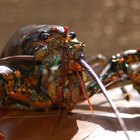
Lobsters are crustaceans, belonging to the same family that includes crabs and shrimp. They have a hard exterior shell called an exoskeleton, which protects and supports the lobster. Lobsters shed this exoskeleton and grow a new one through a process called molting.
Causes
The lobster's exoskeleton does not grow with the lobster as it gets bigger, unlike the skin of other animals. When the lobster outgrows its current exoskeleton, hormones tell the lobster it is time to shed. These hormones originate from the lobster's eyes, which is why cutting off a lobster's eyes triggers a molt.
Process
The exoskeleton detaches from the body, and the skin underneath the exoskeleton forms a new exoskeleton. Once the new exoskeleton is formed, the old exoskeleton breaks apart and falls off. Even though the new exoskeleton is formed, it needs to harden. Until this occurs, the lobster is not able to move around very well.
Frequency
An adult lobster molts even though it is no longer growing, but less frequently than young lobsters. An adult lobster sheds its exoskeleton approximately once per year, while juvenile or young lobsters shed their exoskeleton about five times per year for at least the first five years.
Fun Fact
A lobster with a new exoskeleton that has not fully hardened is called a shedder lobster. These lobsters are usually undesirable for lobster fishermen, because they are delicate and do not store or travel well. In most cases, these lobsters are put back in the water because they are likely to die before they are sold.
Related Articles

When Does a Lobster Molt?

How to Cook Fully Frozen, Whole Lobster ...

Types of Crabs in the Atlantic Ocean

How to Kill a Crab

How to Boil 1.5 Pounds of Lobster

How to Cook Live Lobster on the Grill

How do Mussels Protect Themselves?

How to Steam Lobster & Shrimp

Why are Lobsters Cooked Alive?

How to Cook Blue Crab

How to Devein Tiger Prawns

How to Prepare Frozen Soft-Shell Crabs

Does Lobster Taste Better Boiled or ...

Difference Between Boiled & Grilled ...

When Is King Crab Season?

How to Eat King Crab Legs

How to Thaw Lobster in the Microwave

How to Freeze Whole Live Lobsters

Are Farm Raised Mussels & Clams Healthy ...

How to Cook Crab Claws
References
Photo Credits
Jupiterimages/Brand X Pictures/Getty Images